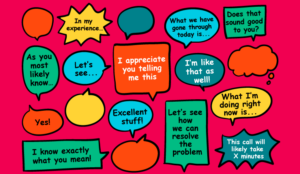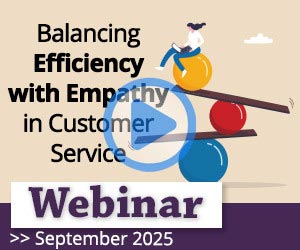Difficult customers can create uncomfortable situations for advisors, which can damage their morale and the working environment.
The only way the contact centre can prepare for these tough scenarios is to train advisors to deal with difficult customers. So, here are some key tips to pass on to your team.
Treat Difficult Customers as an Opportunity to Improve
Too often we see difficult customers as a sign of a dysfunctional organisation, but challenging customers offer us a great chance to find new, innovative solutions, according to Alison Mathiebe, a Training Expert at Call Centre Know How.
Too little conflict can mean that nothing ever changes, that certain voices dominate while others are never heard, and that innovation and creativity are stifled.
Alison Mathiebe
Alison says: “Too much conflict between the customer and advisor can certainly be dysfunctional, distracting, time and resource intensive, and stressful. However, too little conflict can mean that nothing ever changes, that certain voices dominate while others are never heard, and that innovation and creativity are stifled.”
So, difficult customers can be an opportunity for learning and discovering creative solutions that can be passed on to better handle customers with similar issues in the future.
Yet it is easy for an advisor to take a more natural defensive approach when handling difficult customer contacts, and Alison has found that advisors tend to:
Suppress the negativity – Pretend that the conflict is not happening and bite their tongue.
Negotiate with the customer – Ask a customer to compromise and meet them halfway.
Bring in a third party mediator – Ask a colleague to join their call and mediate a solution.
Appeal to authority – Refer an abusive customer to their manager.
Physically avoid the issue – Hang up on the disgruntled customer.
Confront the customer – Challenge the argumentative customer and battle it out.
None of these approaches is in the customer’s or the organisation’s best interests, so the first step that we need to take is to help advisors to change the way that they think about difficult customer conversations.
As Alison says: “When faced with conflict there is an opportunity to reframe the situation as a valuable source of ideas, a reminder to check your assumptions, and an opportunity to be innovative.”
Let the Customer Vent and Ask Yourself These Five Questions
Once you, as the advisor, develop the mindset of using difficult customer contacts as an opportunity to be creative, you can then start to think about the actual call itself and the first stage here is letting the customer vent.
Difficult customers often just want to feel that they are being listened to, wanting to get negative emotions off their chest. So give them the space to vent, remembering that any anger is being directed at the company and not you.
While the customer vents, Alison Mathiebe then recommends that you listen carefully and ask yourself the following five questions, the answers to which can provide valuable information:
- What is the other person’s point of view?
- Why do they think and feel the way that they do?
- What valuable information is this person giving me right now?
- What can this person teach me that I do not already know?
- How can I use this situation to create something new and innovative?
It can be good practice for the advisor to make notes with the answers to these questions, as these will help them to identify the customer’s needs, interests and goals, which are key to finding a successful solution.
Also, it is good for advisors to practise this during induction training, while listening to a call recording. This will help them know what to expect when handling a difficult customer call, to better prepare for a future uncomfortable situation.

Alison Mathiebe
In training, Alison recommends that you remind advisors that “difficult customers are necessary to stimulate new ideas, to nudge people and organisations to recognise and adapt to complex environments, and to generate creativity and innovation.”
“Without different points of view (even those presented most forcefully) we might blindly follow the well-trodden path, make decisions with imperfect information, or fail to test our own assumptions. Without criticism we can remain oblivious to our blind spots.”
For more suggestions of training activities that can really benefit the contact centre, read our article: 9 Fun Customer Service Training Exercises
Teach These Three Steps to Finding a Successful Solution
Once the customer has been afforded the opportunity to vent, you can follow these three steps to help find a positive outcome.
Step 1 – Identify Your Goals, Interests and Needs
Too often when struggling to find a suitable solution the customer and advisor can be come “positional”, i.e. they adopt a position and fight hard for it. Both then find themselves stuck in their positions.
An alternative approach that Alison Mathiebe suggests is to focus on interests and not positions. So, when you find yourself entering into a heated conversation, put your emotions aside for a moment and think carefully about what it is that you want to achieve.
Resist temptations to simply win an argument or beat the other person and concentrate on where you are now and where you want to be in the future.
Alison explains: “Focus on your goals, interests and needs, rather than a pre-set position. Resist temptations to simply win an argument or beat the other person and concentrate on where you are now and where you want to be in the future.”
“In short, adopt an interest-based rather than a positional approach to the interaction.”
Step 2 – Identify the Customer’s Goals, Interests and Needs
Once you are clear about what it is that you want to achieve, make sure that you are certain of what the customer’s goals, interests and needs are. This should have started during the time when you allowed them to vent at the start of the call.
If you are still unsure as to the customer’s intentions, use intelligent, probing questions – while maintaining an empathetic tone – and listen carefully to what lies behind their response. What is it that they really need or want from the situation?
Pay less attention to their position and more attention to their interests, while ignoring any attempts to bait you into an argument.
Alison adds: “Pay less attention to their position and more attention to their interests, while ignoring any attempts to bait you into an argument.”
“Calmly and sincerely ask them what they need to have their interests met. Listen for near, medium and longer-term goals that they might have.”
Step 3 – Find Creative Ways to Meet Everyone’s Goals, Interests and Needs
Now we have identified our own and our customer’s interests (not positions) we need to look for creative ways to bring these interests together collectively.
Giving an example of this Alison says: “Two sisters are arguing over the last remaining orange in the house. Both sisters wanted the orange. Sister A argues that she should get the orange because she is older. Sister B argues that she should get the orange because she saw it first. Neither sister will budge on their position and they end up cutting the orange in half to avoid further conflict.”
“Sister A peels her half of the orange, eats the fruit, and throws the peel away. Sister B peels her half, uses the rind for a cake, and throws the fruit away.”
“If the sisters had taken a little time to discover what their respective interests were, they would have realised that both sets of needs could be met fully and simply through creative problem solving.”
In the contact centre, it may be a little more difficult to find a solution, but it’s easier when you consider each of the following questions:
- To solve similar issues, what have other advisors done?
- Do our competitors do something that could help to resolve this issue?
- Is there someone from another department that could help me in resolving this problem?
- Is there any information that management may have that could prove helpful?
Create an Escalation Policy
So far we have discussed difficult customers as being the type of customer that is frustrated and poses us with a challenging query.
When posing this challenging query, the frustrated customer may quickly become impatient and might ask to speak to a manager. Advisors need to feel comfortable in what to do next in these situations.

The frustrated customer may quickly become impatient and might ask to speak to a manager. Advisors need to feel comfortable in what to do next in these situations.
While good coaching in accordance with the tips above will likely minimise the chances of this happening, there still will be those customers that look to speak directly to the manager.
The first thing to do here is to get the caller to open up, acknowledging the fact that they are upset, and show empathy. If the caller does open up, you can make the decision whether the call needs to be escalated. If not, offer a call-back with a manager, so they can choose to either stay on the line and have their query answered immediately or take the advisor up on the call-back offer.
This advice will lower the number of calls the manager has to take charge of, while having a clear policy will make advisors more confident in controlling the call.
For more on dealing with these situations, we suggest reading our article: How to Handle Call Escalations
Show Empathy and Respect Throughout
Whenever dealing with difficult customers in the contact centre, it is important to remain respectful and to show empathy when a customer expresses their frustration.
Reflect back the words that the customer uses to communicate their frustration, so the customer knows that you have been listening, while maintaining a soft tone.
Reflect back the words that the customer uses to communicate their frustration, so the customer knows that you have been listening, while maintaining a soft tone. Verbal nods will help with this, as if you remain silent as the customer talks, you may begin to feel helpless.
Other quick tips for showing empathy and helping to build rapport include smiling while talking to communicate with a positive tone, repeating the problem back to the customer so they feel completely understood and using personal pronouns to show direct interest in them as an individual.
For more advice and phrases that help to convey empathy, read our article: 18 Empathy Statements That Help Improve Customer-Agent Rapport
In Summary
When handling a challenging query from a difficult customer, first change your perspective – away from a natural defensive approach and towards the idea that this is an opportunity for learning.
Then, let the customer vent the full details of their issues, asking probing questions to attain any information that may prove useful in finding a solution.
When finding a solution, focus on the customer’s and your own key interests, before assessing creative ways of bringing them together.
If there is a failure in this process, create an escalation policy so the advisor feels confident as to what they should do if the customer wants to speak to a manager.
Then, there is the final key point of ensuring that you are actively listening to the customer, while showing empathy and remaining respectful.
For more on the topic of handling challenging customer contacts, read our articles:
- Dealing With Angry Customers
- When Is It OK to Hang up on a Customer?
- “I’d Like to Speak to a Manager” – 7 Ways to Deal With Difficult Customers
Author: Robyn Coppell
Published On: 13th Feb 2019 - Last modified: 14th Aug 2025
Read more about - Skills, Angry Customers, Call Handling, Complaints, Customer Management, Editor's Picks, Empathy, Handling Customers, Skill Development







































